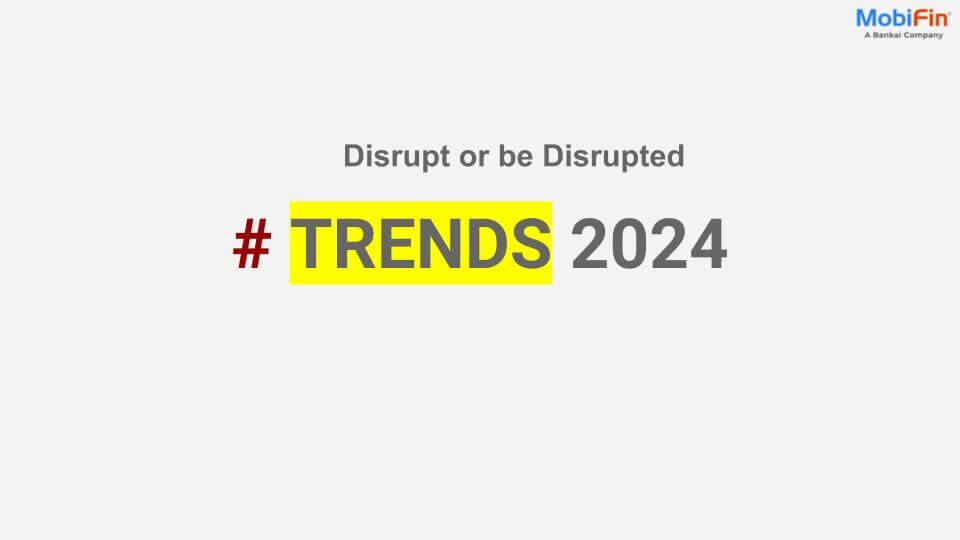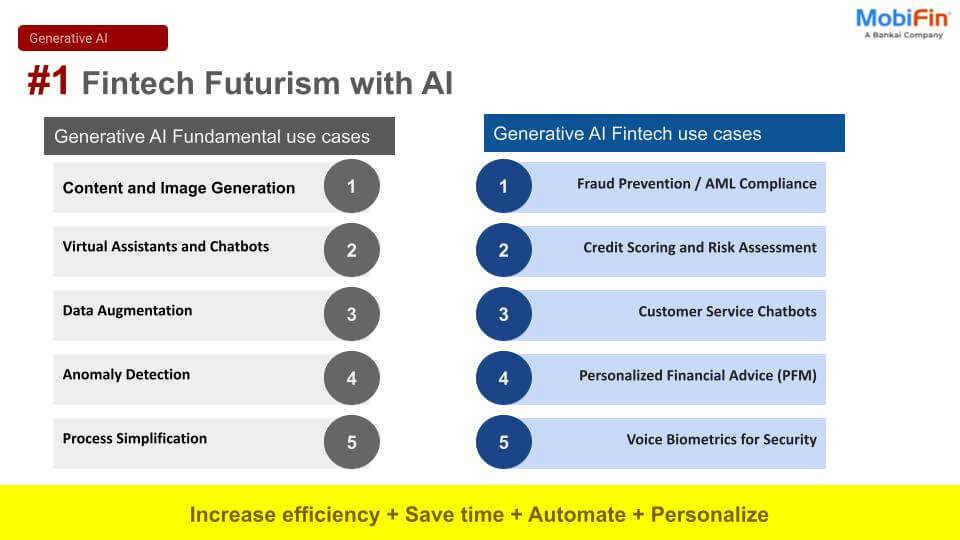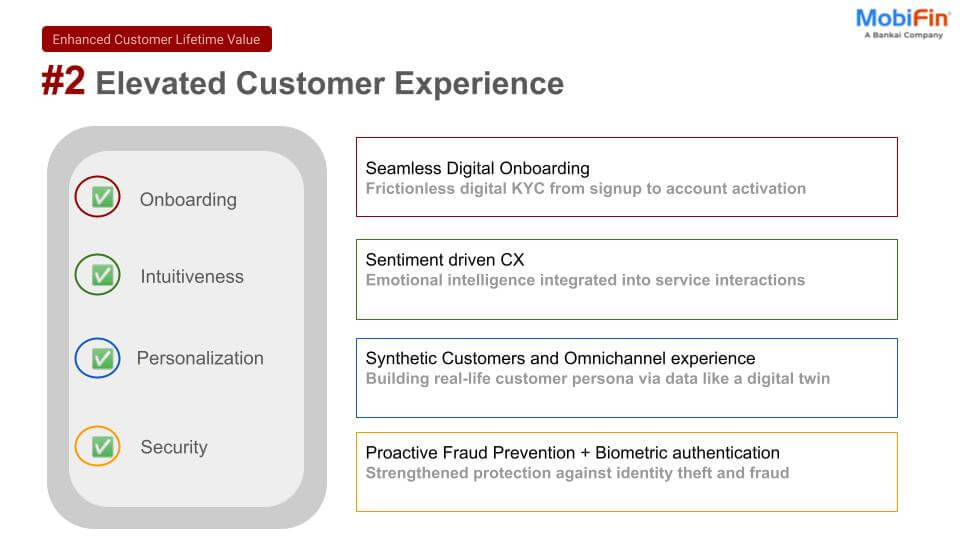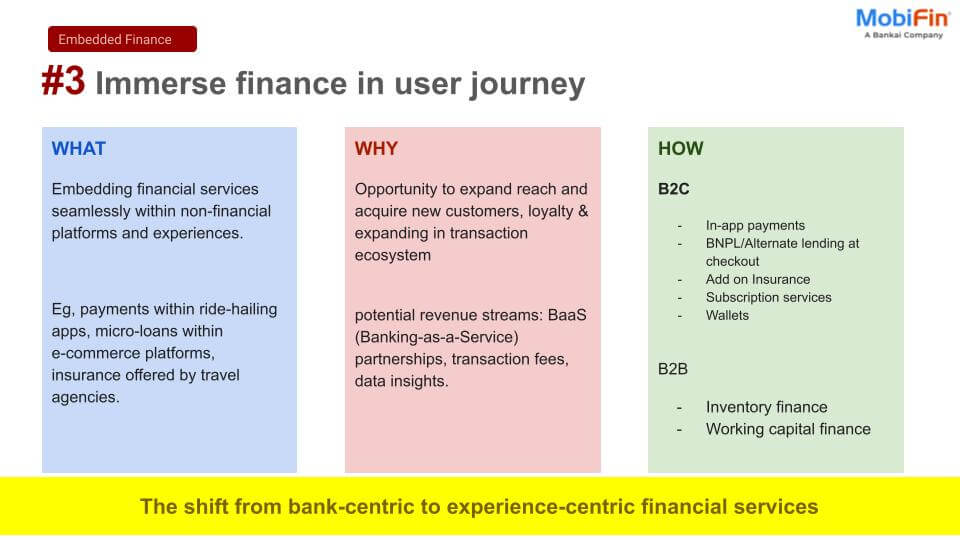So the future of financial institutions (FIs) lies in adopting omnichannel solutions that integrate digital and physical channels to provide a unified, personalized and convenient banking experience. In short, an omnichannel banking solution lets you put banking where your customer needs it and let them bank with you as they need to.
In this article, we will understand how omnichannel banking solutions are becoming the backbone of FIs that are set to stay relevant, competitive, and preferred by customers:
Creating New Revenue Streams and Market Opportunities
Omnichannel banking solutions are changing the way FIs approach their business strategies and create new revenue streams. Being able to break into new territories and customer segments is the first and foremost benefit of going omnichannel as it puts customers at the center of the banking infrastructure:
Capturing Untapped Customer Segments
As evident, omnichannel banking allows banks to capture previously untapped customer segments. It helps them cater to tech-savvy millennials and newer, digital native generations who prefer to manage their finances through mobile apps and online platforms of their choice. Since the banking capabilities sit natively on these third-party platforms, banking becomes a small part of their experience on the respective platform while still keeping your FI in the loop. At the same time, omnichannel solutions can cater to the needs of underbanked or unbanked populations by providing accessible and affordable financial services through alternative channels such as mobile wallets and agent banking networks.
Expanding into New Geographical Markets
Omnichannel banking solutions enable financial institutions to break free from the limitations of physical branch networks and expand into new geographical markets. This is done by either combining the physical presence of partners with digital banking capabilities (agency banking) or by digital-first banking solutions like mobile wallets. This lowers the entry barrier as the traditional brick-and-mortar infrastructure is out of the picture while the FI will still manage to meet the target audience’s expectations head on. Hence, omnichannel banking is a great way to tap into previously inaccessible market opportunities, diversify their customer base, and generate new revenue streams.
More Cross-Sell and Upsell Opportunities
With omnichannel banking, there will be more digital touchpoints and more data for banks and FIs to play with. Analyzing that data will help them get to know their customers better – their financial behavior, preferences and needs across those touchpoints. The real benefit is to identify the moments in the customer journey to offer relevant and personal products and services. That means more conversions for cross-sell and upsell.
Personalized Product Recommendations and Targeted Marketing
As we’ve discussed, having granular customer data at your disposal means you can use technologies like machine learning and AI-enabled advanced analytics to run targeted marketing campaigns. For example, if a customer uses their credit card for travel expenses, the bank can proactively offer them a travel rewards credit card or foreign currency exchange service. If a customer’s transaction history shows a growing balance in their savings account, the bank can suggest investment products or wealth management services to help them get more returns. It’s common sense but it requires technology to apply and scale in a volatile, cost conscious market.
Increasing Customer Lifetime Value through Loyalty Programs
Now that we’ve covered that, omnichannel banking solutions also offer FIs another way to retain old customers who are struggling with aging infrastructure and processes: using customer data to create and manage loyalty programs that cover all touchpoints. Reward customers for their engagement and transactions across all channels and you’ll build long term relationships that increase customer lifetime value and repeat business. These loyalty programs can include points based rewards, cashback offers, exclusive discounts and personalized promotions that encourage customers to deepen their relationship with the bank.
Working with Fintech Partners
Since embedded banking has become the new normal, FIs are taking the collaboration route to get omnichannel fast with the help of FinTech players. These partnerships allow banks to tap into the expertise and agility of fintech companies to build and integrate new solutions into the existing banking infrastructure. Together they can co-create products and services that meet the evolving needs of customers and fill the gaps in each other’s business models.
Open Banking and API Driven Architecture
Open banking and API driven architecture are the enablers of omnichannel banking solutions. Banks must expose their APIs to third party developers and fintech companies to create an ecosystem of financial services and applications around themselves. This makes FIs part of the open banking movement which is a win-win for both themselves and the customers.
Operational Efficiency and Cost Optimization
In addition to revenue growth, omnichannel banking solutions also help FIs to streamline their operations, reduce costs and become more efficient. This is done by automating manual processes, consolidating customer data and optimizing resource allocation.
Streamlining Back Office and Reducing Manual Work
Omnichannel banking solutions enable FIs to automate and digitize various back-office processes. This includes account opening, loan origination and compliance checks. Tools like robotic process automation (RPA) and workflow automation tools are becoming more useful in doing so. So, errors and document mismanagement will decline heavily as manual data entry is reduced. While operational efficiency will benefit from automation, the fact that it frees up employee time so they can redirect it to more strategic and customer facing activities is the biggest upside. And that’s even more important as AI is being used with little to no regard for the human touch that is essential to nurture something as important as trust in finance.
Branch Network and Resource Optimization
With omnichannel banking, FIs can strategically optimize their branch network and resource allocation. Underutilization and underperformance of physical branches is a top concern for banks of all sizes and business focus. Customer behavior and preferences across channels.
Looking at customer behavior and preferences across channels, banks can identify opportunities to consolidate or repurpose underperforming branches and invest in high footfall locations and digital capabilities. This data driven approach allows banks to make informed decisions about their physical footprint, staffing and technology investments and ultimately cost efficiency and customer alignment.
Competitive Advantage and Market Positioning
In a competitive and digital first banking world, omnichannel solutions give financial institutions a way to stand out and strengthen their market position. By delivering a better customer experience, innovative products and services and seamless channel integration, banks can build a strong brand and be ahead of the competition.
Working with Fintechs to Innovate
To stay ahead of the game and meet changing customer expectations, financial institutions are working with fintechs to co-create omnichannel banking solutions. By leveraging the agility, expertise and technology of fintech partners, banks can speed up their digital transformation and get new products and services to market faster. These partnerships allow financial institutions to access new revenue streams, enhance their value proposition and be seen as innovation leaders in the industry.
Building a Customer Focused Brand
Omnichannel banking gives financial institutions the opportunity to build a strong brand. By delivering great experiences across all touchpoints banks can build trust, loyalty and advocacy with their customer base. This positive brand will help attract new customers, retain existing ones and differentiate from competitors who may not have omnichannel and customer centricity.
Efficiency and Cost Savings
As well as improving the customer experience, omnichannel banking solutions can also help financial institutions optimize efficiency and reduce costs. By simplifying and automating back-office processes, banks can get rid of manual tasks, reduce errors and increase productivity. For example, implementing robotic process automation (RPA) can automate tasks like account opening, loan processing and compliance checks and free up resources so staff can focus on more strategic activities.
Back Office Efficiency
Omnichannel banking solutions benefit customers and back offices too. By integrating systems and processes across channels banks can eliminate data silos, reduce manual interventions and automate repetitive tasks.
For example, RPA can automate tasks like account opening, loan processing and fraud detection. This reduces human error and frees up bank staff to focus on strategic initiatives and customer facing activities. Using cloud and APIs, banks can ensure real time data sync across channels and make faster decisions and respond to customer needs.
Simplifying Customer Onboarding and KYC
Omnichannel banking solutions can simplify the customer onboarding process and KYC compliance. By using digital technologies like biometric authentication, electronic signatures and document verification, banks can do remote account opening and reduce the need for physical paperwork. This not only improves the customer experience by giving a convenient and hassle-free onboarding process but also allows banks to expand beyond geographical boundaries.
Among many other aspects of banking, these two display a powerful glimpse of cost savings and operational efficiency going hand in hand in an omnichannel banking setting.
How to Measure Omnichannel Banking?
To measure the success of omnichannel banking, financial institutions need to have clear metrics and key performance indicators (KPIs). These could be customer satisfaction scores, channel adoption rates, cross sell ratios and operational efficiency metrics. By monitoring and analyzing these metrics regularly, banks can identify areas to improve, optimize their omnichannel strategy and get a return on investment.
Conclusion
Omnichannel banking solutions are shaping the future of financial institutions by changing the way banks interact with customers and internally. By providing a seamless and personalized banking experience across all channels, optimizing efficiency and collaborating with fintech partners, banks can be future ready. As the industry evolves, omnichannel banking will be key for financial institutions to remain relevant, competitive and customer focused.
MobiFin provides comprehensive omnichannel banking solutions to financial institutions.
Contact us now to explore how MobiFin’s omnichannel banking can drive inclusion and growth for you.













